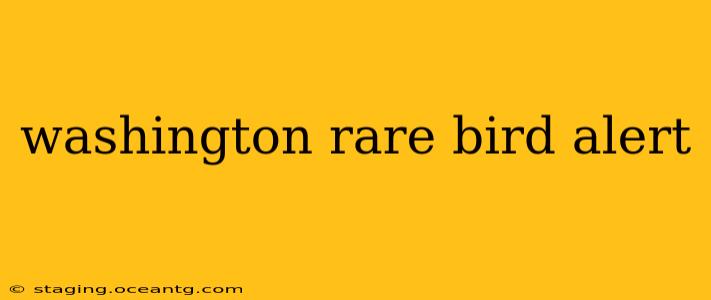Washington state boasts a rich tapestry of avian life, attracting bird enthusiasts from across the globe. But the thrill of birding lies not just in spotting common species, but in encountering those rare and elusive feathered visitors. This guide serves as your ultimate resource for staying updated on Washington rare bird alerts and maximizing your chances of witnessing these avian wonders.
What Constitutes a "Rare Bird" in Washington?
Before we dive into specific alerts, let's define what makes a bird "rare" in Washington. Rarity is typically determined by a combination of factors:
- Infrequency of Occurrence: A bird is considered rare if it's rarely seen within a specific geographic area and time frame. This can be due to its limited breeding range, migration patterns, or vagrant behavior (straying far from its usual habitat).
- Conservation Status: Some species are inherently rare due to their conservation status, making any sighting significant.
- Unpredictability: Rare bird sightings are often unpredictable, making their appearance a surprising and exciting event for bird watchers.
Many birders use the term "rare bird" loosely for any uncommon sighting, making the distinction somewhat subjective. However, rarity often indicates a bird species significantly outside its expected range.
Where to Find Washington Rare Bird Alerts?
Staying informed about rare bird sightings requires proactive monitoring of several key sources:
- eBird: eBird is a comprehensive online database maintained by the Cornell Lab of Ornithology. It's an excellent resource for real-time sightings reported by birders across Washington. The platform allows you to filter by location, species, and date, helping you focus on areas of interest and recent rare bird reports.
- Washington Rare Bird Alerts Online Forums: Various online birding forums and social media groups dedicated to Washington birding provide instant updates on rare bird sightings. Searching for "Washington birding forums" will reveal numerous options. Join these communities to participate in discussions and receive alerts directly.
- Local Audubon Chapters: Your local Audubon chapter frequently publishes newsletters or maintains a website with updates on rare bird activity within the region. These organizations often have strong connections with local birders and can provide reliable information.
- Bird Reporting Hotlines: Some regions maintain dedicated bird reporting hotlines where birders can report sightings and obtain information on recent rarities.
How to Ethically Observe Rare Birds in Washington
Responsible birding is essential when encountering rare species. Here's how to ensure your observation doesn't negatively impact the bird or its habitat:
- Maintain a Respectful Distance: Never approach a rare bird too closely. This can cause stress and disrupt its natural behavior, particularly during breeding or feeding. Use binoculars or spotting scopes for observation from a safe distance.
- Avoid Disturbances: Minimize noise and movement. Refrain from playing recordings or using flash photography, which can frighten the bird.
- Respect Private Property: Ensure you have permission before entering private land to observe a bird.
- Share Sightings Responsibly: Report sightings to appropriate databases and forums, but avoid disclosing precise locations that could lead to overcrowding or harassment of the bird.
What are some of the rarest birds seen in Washington state?
The rarity of a bird can vary from year to year, depending on migration patterns and other factors. Some birds considered particularly rare in Washington include various vagrants from the north (like species normally found in Alaska or Canada) or unusual southern visitors. Specific species are best tracked through the resources mentioned earlier—eBird and local birding communities are your best bet for the most up-to-date information.
How can I increase my chances of seeing a rare bird in Washington?
To improve your chances, combine thorough research with strategic birding practices. Utilize the alert systems mentioned above, focus your birding efforts in areas known for attracting vagrant species (coastal areas are often prime locations), and be patient and observant.
What is the best time of year to see rare birds in Washington?
Migration periods (spring and fall) are typically the best times to spot rare birds in Washington, as birds may stray off course during their long journeys. However, rare sightings can occur at any time of year.
Are there any ethical concerns regarding the observation of rare birds?
Absolutely. The ethical concerns center around minimizing the impact on the bird and its habitat. Avoid disturbing the bird, respect private property, and report sightings responsibly without revealing overly specific locations that could lead to harassment.
By following these guidelines and actively utilizing the resources mentioned above, you can greatly improve your chances of observing a rare bird in Washington, while contributing to the ethical and responsible enjoyment of this fascinating hobby. Remember, responsible birding ensures the preservation of these incredible creatures for generations to come.
